No.3  July 2008 July 2008 | ||
 |
Crop Prospects and Food Situation | |
|
Regional reviews
In North Africa, harvesting of the winter grains (mainly wheat and barley), which make up the bulk of the subregion's cereal crop, is underway and FAO’s latest forecasts put the subregion’s aggregate output of wheat (the main crop) at nearly 16 million tonnes, 18 percent up from the previous year's drought-reduced level, while that of barley is put at some 3 million tonnes, about 7 percent up from 2007. The outlook is favourable in Egypt, the largest producer of the subregion, where wheat output is expected to be about 12 percent up from last year and 9 percent above the recent average. In Algeria, the wheat crop is also forecast above average by about 7 percent. In Morocco, latest forecasts point out to a substantial recovery in cereal production from last year's drought-reduced crop, although output would remain below average. The wheat harvest is forecast at 3.7 million tonnes, more than double last year’s poor level but still about 15 percent below the average. By contrast, in Tunisia prospects are less favourable and smaller crops are expected this year, mainly as a consequence of insufficient soil moisture at planting and subsequent erratic rains in the main growing areas. In spite of government incentives to farmers to increase production, wheat output is provisionally forecast to decrease from last year’s 1.4 million tonnes to some 870 000 tonnes. A below-average barley output is also anticipated.
North African countries have been seriously affected by high international cereal prices due to their high dependence on imports. Governments have implemented a series of measures aimed at offsetting the sharp increase in world prices, including the waiving of tariffs, price controls and subsidies, which have put a considerable strain on public finances. In Algeria for example the bread subsidy system is estimated to cost the Government about USD 50 million each month. In spite of these measures inflation continues to accelerate across the subregion: In Egypt, the year-on-year rate of inflation reached 16.4 percent in April 2008 up from 6.9 percent in December 2007, driven mainly by price increases in the food sector where the year-on-year rate of inflation jumped from 8.6 percent in December 2007 to 22 percent in April 2008. The anticipated increase in wheat production, notably in Morocco and Egypt, is expected to ease the effects of rising international commodity prices on access to food in these countries. Even in Tunisia where production is forecast to decline significantly, consumer price inflation decelerated for the first time in almost a year to 5.3 percent in May. The arrival of the new local harvest to the market pushed food price inflation down to 7.1 percent in May from 8.1 percent in April. 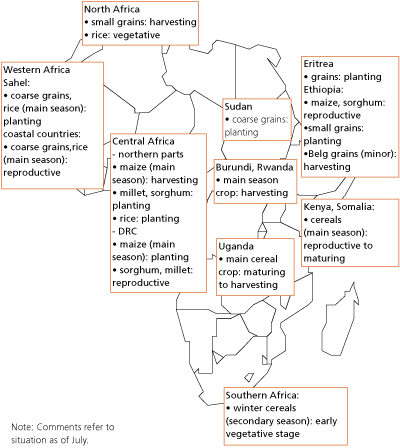
High and rising food prices continue to affect consumers’ purchasing power and access to food across the subregion in spite of the various measures taken by governments. In Dakar, the capital of Senegal, the price of imported rice, the most important staple food, was 20 percent higher in April 2008 compared to the same period last year. In the same country, this number reached 43.1 percent in Diourbel and 47.1 percent in Tambacounda. In the central and eastern part of the subregion, which is less dependent on cereal imports from the international market the situation is not better: In Ouagadougou ( Burkina Faso), Bamako ( Mali) and Niamey ( Niger), the price of millet, the major staple in these countries, has increased by 33 percent, 33 percent and 24 percent respectively in early June 2008 compared to the same period last year. Over the same period the price of imported rice was up 87 percent, 39 percent and 13 percent respectively. The upward trend in cereal prices is likely to continue until new local harvests come to markets. 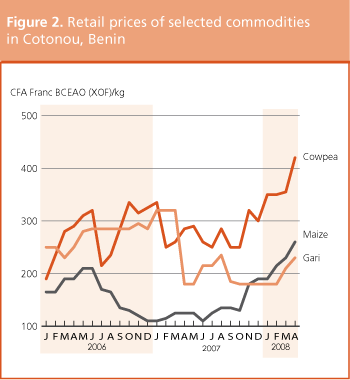
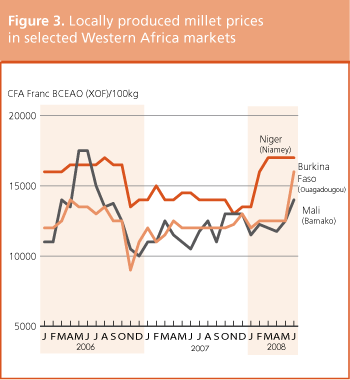

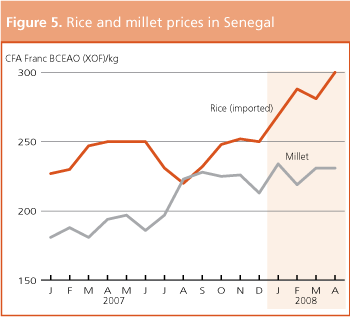
The evolution of the food situation in the short term will depend heavily on the output of the cropping season which has just started. Area is likely to expand significantly driven by high prices and various measures taken to improve production including provision of seed and fertilizer subsidies. However, rainfall is still the major determinant of yield due to the limited extent of irrigated land. Although rains have been erratic so far across the subregion, precipitations are expected to improve in the coming months according to the African Centre of Meteorological Applications for Development (ACMAD) and the Agrhymet Centre in their annual climate prediction exercise. For the Sahelian region, which receives about 80 percent of its annual precipitation in the months July-September, there is an increased probability this year of normal to above-normal rainfall. For coastal countries along the Gulf of Guinea, near normal rainfall is forecast. In the latter countries, the rainy season is now well established, and the main season maize crop is developing satisfactorily in the south and the centre while the single-season millet and sorghum are emerging in the north. In short, overall early crop prospects are favourable in West Africa and the current tight food situation is expected to ease somewhat from September on.
In Central Africa, in spite of measures taken by Governments to cushion the impact of high international commodity prices, food prices continue to climb on domestic markets, seriously eroding the purchasing power of consumers. In the Central African Republic, the price of rice increased by 71 percent between January and June. Prices of other food items such as cassava, oil and meat more than doubled over the same period. In Cameroon, where the Government recently increased the salaries of civil servants by 15 percent and waived import tariffs on a set of foodstuffs, food prices continue to increase as well. In both countries, rains have been adequate since the beginning of the cropping season in April and harvesting of the first 2008 maize crop is about to start. This is expected to ease the effects of rising international commodity prices. In the Central African Republic, however, agricultural recovery continues to be hampered by persistent civil unrest and inadequate availability of agricultural inputs, notably in northern parts where nearly 300 000 people have reportedly been uprooted from their homes over the past two years. Continuing insecurity in both Chad and the Darfur region of Sudan threaten to further destabilize the situation in northern parts of the country.
Harvesting of the 2008 main season cereal crops is underway or due to start soon in Somalia, Tanzania, Uganda and Kenya. In Ethiopia the harvest of the secondary 'belg” crop is in progress. Although the important March-May rains improved towards the end of the period, cumulative totals remain below normal in large areas of Ethiopia, Somalia, parts of western Kenya and in the Karamoja region of Uganda. Thus, crop prospects in these countries remain generally poor. Planting of the 2008 main coarse grain crops has started in Sudan. In Eritrea,sowings are underway for the 'Kiremti” cereal crops due for harvest from November. The vegetation Index (NDVI) is low in North Red Sea region reflecting below-average rains during the first months of 2008. In the central highlands growing conditions are reported normal following adequate rainfall. Reflecting generally favourable weather and a marginal increase in the area planted to sorghum, the main cereal grown, the aggregate 2007 cereal production is estimated to have increased by some 60 000 tonnes to 462 000 tonnes. However, despite significant increases in the last few years, domestic cereal production is inadequate to cover the requirements and large quantities of cereals have to be imported. Food prices in the Asmara market have been on an upward trend since July 2007, with serious implications for a large number of vulnerable people. In Ethiopia, notwithstanding moderate rains in May, the cumulative total for the March to May season was below normal, resulting in drought conditions across an extensive area of the country, including the secondary 'belg” crop areas. As a result, the output from this crop, now being harvested, is expected to be severely reduced compared to the bumper harvests of the last few years. Decreased water availability is reported in several regions with Afar, Somali and the lowlands of Oromiya the most severely affected. By contrast, western Ethiopia has experienced abundant and well distributed rains since the season started in late March. The May rains were beneficial for the growing of the early sown main 'meher” crop, the output of which, however, will largely depend on weather conditions until the harvest due from October. In Kenya, below-average March to May rains in Northern Rift Valley and North-western provinces have further reduced water availability, which was already inadequate as a result of a poor October-December 2007 season. Maize output in the key grain-producing districts in the North Rift region like Trans-Nzoia, Uasin Gishu and Lugari is expected to be drastically reduced. In addition to the displacement of farmers and irregular weather patterns, the factors behind the decline in production include rising fuel and agricultural inputs prices and high cost of labour. Following adequate rains in the bimodal areas of South Rift and western Kenya, the maize crop is reported in good condition and a few farmers in some of the early planted areas the South Rift Valley, have reported the harvesting of green/fresh maize suggesting that harvesting in these areas could start timely in August. The Ministry of Agriculture has estimated the long rains production of maize this year at 2.16 million tonnes, about 20 percent lower than in 2007/08 and 15 percent below the recent average. In an effort to increase cereal production the Government has initiated a number of projects which include diversification of crops, intervention in the input supply with provision of fertilizers, seeds, tractors for hire and a credit facility for the farmers. In Somalia, the main Gu cereal crop, due for harvest from next month, is largely anticipated to be a failure as a result of a late start and poor performance of the rains in most parts of the country. Crops in many southern areas had already wilted and dried by the end of May and although light rains in early June led to a replenishment of water resources, the y arrived too late to benefit the crop. Recent heavy rains have caused some flooding in Mogadishu. Dry conditions have prevailed also in the central pastoral regions of Galagadud and Hiran as well as in several pastoral areas of the north. Crop conditions are extremely poor in both sorghum and maize areas and the vegetation index of maize in Lower Shabelle at this time of the year is the lowest recorded over the last ten years. In Sudan, the output from the irrigated wheat crop harvested earlier in the year is estimated at 587 000 tonnes, above the 5-year average but 16 percent below the bumper 2007 crop. Planting of the 2008 coarse grain crops, mainly sorghum and millet has started. The availability of agricultural inputs is reported as normal to above-normal. Rains from July to September will be crucial for the establishment and development of the crops, the bulk of which are due for harvest from November. In the United Republic of Tanzania, harvesting of the main coarse grain crops, mostly maize, will be completed next month. Reflecting normal rains, the output is expected to be up from last year and above the 5-year average. Paddy production is likely to be marginally higher than last year’s crop of 1.4 million tonnes. The good harvest is expected to meet national food requirements and result in a decline of wholesale cereal prices as already reported from Mbeya District. In Uganda, harvesting of the main coarse grain crops is underway. Normal rains in most of the country’s growing areas suggest normal crop and livestock production. In contrast, below-normal rains in the Karamoja region will result in poor outputs for the second consecutive year.
In Somalia, the failure of the 2008 Gu crop, which follows two below-average seasons (Gu 2007 and Deyr 2007/08), has resulted in a critical food supply position. The humanitarian situation is rapidly deteriorating due to a combination of increasing food prices, a significant devaluation of the Somali Shilling, disruption of internal markets and internal trade, and mounting civil insecurity. Currently, 2.6 million people are estimated to be in need of assistance ' about one-third of the total population - an increase of more than 40 percent since January 2008. The number of internally-displaced people are estimated at 1.1 million. Population movement from the capital increased by 20 percent since January 2008 bringing the number of people who have fled Mogadishu since February 2007 to a total of 860 000. According to the FSAU (Food Security Analysis Unit) the humanitarian situation is likely to continue to deteriorate in the coming months and a total of 3.5 million people, about half of the total population, could be in need of either livelihood support or humanitarian assistance by the end of the year. In Ethiopia drought conditions are reported across an extensive area of the country, including those where the secondary 'belg' crop is produced. Although this crop accounts for only a small portion of the total national cereal production, in Amhara and Tigray regions, where the output is severely reduced, about one million people depend on this crop for about half of their annual food consumption. Recently, the Government and humanitarian partners estimated a requirement of some 510 000 tonnes of cereals to meet emergency food assistance needs for 4.6 million people until November 2008. This estimate of the number of people in need represents an increase of 2.6 million people compared to the April 2008 estimate. Moreover, this figure could increase further as an additional 8 million people remain chronically food insecure. Out of a total requirement of 598 000 tonnes, only about 130 000 tonnes, or 30 percent, are available or have been pledged. Thus, to avoid a further worsening of the food supply position of the affected people, there is an immediate need for contributions to the food aid pipeline. WFP has announced that, due to funding shortfalls, it has been forced to reduce food assistance to tens of thousands beneficiaries in drought-affected areas and that, without new contributions, may not be able to fully respond to the increasing food aid requirements resulting from the drought. In an effort to reduce the impact of 20 percent inflation on poor people, the Government decided to cancel the value-added and turnover taxes on food grains and flour - which constitute more than half of the country’s food consumption - as well as all types of tax imposed on cooking oil, and surtax on soap. The Government has also set up measures which include provision of direct and indirect subsidies, and has spent ETB 372 million (USD 38 million) to subsidise wheat and ETB 3.52 billion (USD 366 million) to subsidise fuel. The current monthly distribution of 25 kg of wheat for low-income urban dwellers, introduced in March 2007, will be maintained as well as distribution of edible oil and other products. Relief assistance will be required by pastoral population and the urban poor in Djibouti as a result of decreasing food security reflecting inadequate rains and increasing food prices. Direct and indirect resource transfers, including market subsidies and provision of food and water are needed to support the rising number of food insecure households. Preventive health measures are also needed to avoid outbreaks of waterborne diseases. In Eritrea, current high food prices and inflation continue to affect a large number of vulnerable people while new and continuing regional tension could lead to further massive displacement and increased humanitarian needs. Disease outbreaks including cholera and malaria remain a concern as a result of the ongoing rainy season. This condition will be further aggravated by inadequate safe water sources and sanitation facilities and other endemic diseases, such as yellow fever and meningitis. Adequate rains in Kenya since the season begun in March, over most of the pastoralist areas, have improved the availability of pasture and water, promoting livestock productivity and milk output. However, conflicts, high prices for cereals and other essential goods, animal diseases like Peste des Petits Ruminants (PPR) currently widespread in northern areas, have minimized the extent to which pastoralists can benefit from the rains, have undermined their recovery from drought, and increased their food insecurity. Overall the food security situation is likely to deteriorate due to drought, food production losses due to animal and crop diseases, increasing prices for food and agricultural inputs, as well as disruption of markets. More than 500 000 people affected by post-election violence, including 113 000 IDPs settled in 134 camps, as well as about 230 000 IDPs in Mount Elgon districts will continue to require humanitarian and recovery assistance in coming months. A steady influx of refugees from Somalia is reported in the north-eastern province. Households in the eastern parts of southern Sudan are currently highly food insecure due to food shortages as a result of crop losses after last year’s early and above-normal flooding. These shortages are compounded by the isolation from markets, due to inadequate or lack of roads, and insecurity. Food supply position in Rubkina and Ruweng could deteriorate in the coming months due to an escalation of the conflict over the border between northern and southern Sudan that started in December 2007. The estimated 50 000 people internally displaced, as a result of the civil unrest in May in Abeyei, are expected to return to their homes in the next few weeks. In the north, displacement and loss of livelihoods are expected to continue in Darfur where an additional 180 000 people have been displaced in the first five months of this year. Limited humanitarian access due to security restrictions, overcrowding in camps, limited water resources and a poor cereal harvest, would likely lead to increased hardship for the vulnerable people. The food crisis in the north-eastern Karamoja district of Uganda is likely to continue. It is estimated that more than 700 000 people are food insecure and in need of emergency food aid as a result of flood damage in 2007, prolonged insecurity, inadequate rains for the last three years, falling livestock prices, and a severe attack of honeydew on sorghum. The Government has provided some farm implements and seeds to farmers, but the population still needs food relief to bridge supplies up to the next harvest. Adequate food stocks and market supplies are ensuring constant food security in other bimodal areas of the country.
In Eritrea, reflecting widespread increase on international markets, prices for food in Asmara have steadily increased since July 2007. The retail price for wheat flour in May 2008, quoted at ENR 3 700 per 100 kg, was almost 9 percent higher than the previous month and more than double the price prevailing in May 2007. Similarly, the retail maize price reached ERN 2 700 per 100 kg in May 2008, more than double the July 2007 price. In Ethiopia, grain prices continued to increase in 2008 after weakening slightly at the end of 2007. The price of wheat in Addis Ababa in April increased to USD 438 per tonne from USD 426 per tonne in March. Maize in the same market was quoted in April at USD 324 per tonne compared to USD 160 per tonne a year earlier. With prevailing high prices, poor households are expected to find it more difficult to secure access to adequate food supplies. 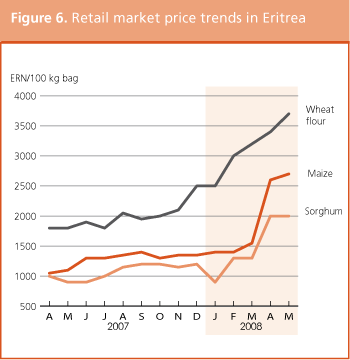
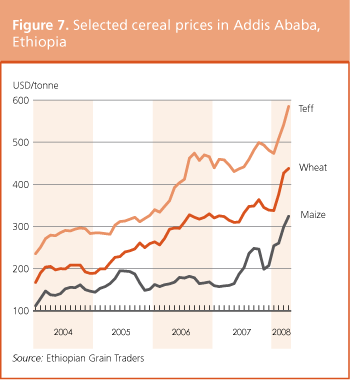
In Kenya, reflecting the sharply reduced maize crop in the key maize-producing districts in the North Rift region, the price of maize in the Nairobi market - which fluctuated between USD 199 per tonne and USD 222 per tonne in the period May 2007 and January 2008 ' had increased to USD 387 per tonne by May 2008. In Somalia, low cereal supplies, as a result of two consecutive poor harvests, a significant increase in the prices of imported commodities and growing demand from IDPs, have resulted in further increases in food prices. Overall, sorghum prices have increased in the Sorghum Belt by more than 60 percent since January 2008. In April, the highest sorghum prices were in Beletweyne market (SOS 7 500 per kg) and Hudur (SOS 7 250 per kg). The lowest prices were reported in Bardera and Baidoa where sorghum was quoted SOS 3 600 per kg and SOS 5 150 per kg, respectively. In Sudan, sorghum and millet prices in all major markets are stable at a high level. This year, the seasonal downward trends in prices, which normally occur during the immediate post-harvest period, were less marked than previous years. The wholesale price of sorghum in Khartoum, which fluctuated between SDG 40 and SDG 47 per 90 kg bag in the period November 2007 and February 2008, had increased to SDG 82 per 90 kg bag by April. Wheat prices, at around SDG 100 per 90 kg bag in the October to December period, reached SDG 140 per 90 kg bag in April.
In the United Republic of Tanzania, reflecting a government export ban on agricultural commodities, imports of large quantities of maize, and favourable prospects for the maize crop now being harvested, wholesale prices in Dar-es-Salaam declined over the past months, the May price, at USD 289 per tonne, was USD 46 below the peak reached in January. In Uganda, in spite of a normal crop forecast the price of maize had risen to USD 370 per tonne in May, some USD 200 per tonne more than just four months earlier in January.
The subregion’s aggregate 2008 cereal production (including forecasts for small amounts of wheat from the secondary season currently underway in a few countries) is estimated at 27.3 million tonnes, up by some 17 percent from 2007, and the highest level since 2000 (see Table 5). This is primarily due to a bumper season in South Africa, where output of maize and other cereals recovered sharply from last year’s poor level. Outputs in Swaziland, Botswana and Mozambique also increased from last year’s mostly poor levels, while Zambia, Malawi, Angola and Zimbabwe gathered smaller crops than in 2007. Regarding maize, the main staple crop in the subregion, aggregate output is estimated at 20 million tonnes, 25 percent higher than last year’s less than satisfactory outcome. Excluding South Africa, the aggregate output of the remaining countries is down compared to last year, but above the 5-year average (Figure 10).
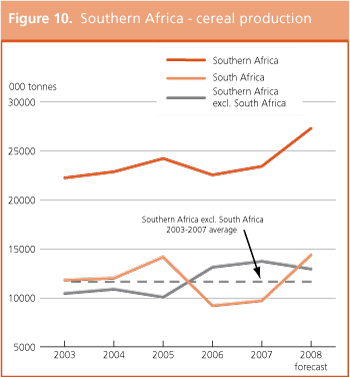
Planting of the 2008 wheat crop in South Africa, which accounts for about 90 percent of the subregion's total wheat production, and other secondary season crop planting, has been carried out in May-June in southern and central growing areas. Early estimates put the area up by about 19 percent from the previous year, in response to the current high domestic and international prices.
Based on the bumper crop in South Africa, FAO estimates a lower cereal import requirement for the subregion as a whole in the 2008/09 marketing year compared to 2007/08. However, excluding South Africa, the aggregate cereal import requirement of the other countries is expected to increase by 11 percent, while for maize, the increase is expected to be even more pronounced at over a third (Table 6 and Figures 11 and 12). As a result of the significant drop in per caput domestic cereal availability, combined with significant reduction in commercial import capacity due to the prevailing high food and fuel prices, demand on food aid is estimated to increase substantially in the subregion.
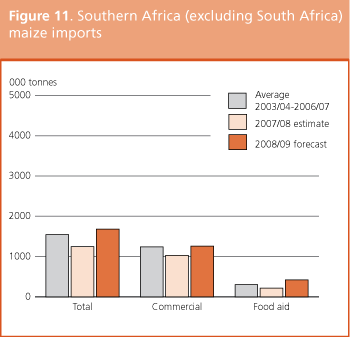
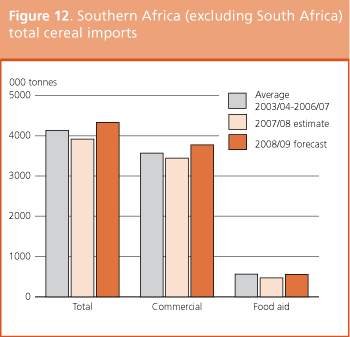
Prices of the main cereals remain higher at the start of this new marketing year than at the same time last year due to strong international and regional demand (Figure 13). In South Africa, following a bumper harvest, the price of maize has weakened somewhat since the start of the season but remains well above the corresponding prices last year. For example, the May 2008 price of white maize (Randfontein spot) at ZAR 1 784 per tonne was 8 percent higher than a year earlier. In Mozambique, the maize price in June 2008 (Maputo wholesale) of MZN 8.57 (Mozambique Metical) per kilogramme was 57 percent higher than for the corresponding month in 2007. In Malawi, the retail maize price in Lilongwe has been rising since May 2007; the spike in the price in April 2008, seems to be the exaggerated reaction of the market due to the uncertain and conflicting early forecast of the current harvest. In Madagascar, the post-harvest rice price has started to go up in June, earlier than usual. 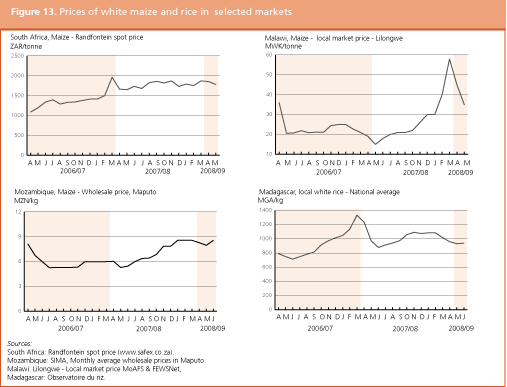
A joint FAO/WFP Crop and Food Supply Assessment Mission (CFSAM) was undertaken at the request of the Government of Zimbabwe from 29 April to 23 May 2008. The Mission estimated total domestic cereal availability for 2008/09 is at 840 000 tonnes, about 40 percent below last year’s domestic supply. National production of 2008 main season maize is estimated at 575 000 tonnes, some 28 percent lower than 2007 output. The 2007 harvest was itself already some 44 percent below 2006 production. The country needs about 2.1 million tonnes of cereals including 1.9 million tons for direct human consumption. Average agricultural production and productivity have declined over the last seven or eight years. Newly resettled farmers cultivate only about half of the total arable land allocated to them owing to shortages of draught power, fuel and low investment in infrastructure. Large-scale commercial farms produce less than one-tenth of the maize they produced in the 1990s. The productivity of the communal farms that used to produce the bulk of maize in the country has also decreased to one-fourth in about 10 years. According to the Mission, Zimbabwe’s cereal import requirement from April 2008 to March 2009 will be at 1.2 million tonnes, of which the staple food maize accounts for about one million tonnes. Total commercial cereal imports could reach 850 000 tonnes, leaving a shortfall of 380 000 tonnes. Required food assistance could amount to 395 000 tonnes of cereals from July 2008 to March 2009. The situation has been exacerbated this year by severe economic constraints, arising from hyperinflation and the continuing balance of payment crisis, the untimely delivery of seeds, shortages of fertilizer, unprofitable cereal prices, deteriorating infrastructure and a prolonged dry spell following excessive rains. There seems to be little incentive for farmers to produce beyond their subsistence needs, given the lack of alternative marketing channel and price controls with inflexible procurement prices in an environment of hyperinflation (see Figure 1). Prices of maize and of several other key commodities are controlled by GMB by setting the buying price for farmers and the selling price for millers (and their price of maize meal to consumers), for vulnerable groups and other commercial users (mostly as animal feed). Maize is, however, traded in small quantities by farmers (so called 'farmer-to-farmer' sales) and petty traders at informal and often hidden, markets. The GMB procurement price, which is uniform across the country, has increased in discrete steps, and has generally remained well below the parallel market retail price. Even though the rise in the current price of maize lags behind the dizzying general price inflation, prices in US dollar equivalent are keeping the upward trend due to the dismal harvest this year and rising prices in the international market. Further, rural labour markets are largely dysfunctional and inefficient due to imperfect information on going wage rates and labour surplus/deficit pockets especially in an escalating inflationary environment. High transport costs and physical separation of surplus areas (generally associated with the communal localities) and high demand areas (typically in large-scale commercial and A2 farming areas) have exacerbated supply problems. Zimbabwe’s economy has shrunk by about 45 percent between 1998 and 2007, with an annual inflation rate estimated at over 350 000 percent for March 2008, the highest worldwide. This has dramatically eroded people’s purchasing power, limiting their access to the meagre local food supplies.
Household food security analysis shows that about 2 million people in rural and urban areas are likely to be food insecure between July and September 2008, rising to 3.8 million people between October and December, peaking at about 5 million at the height of the hungry season between January and March 2009. The food insecure population would require food assistance amounting to some 395 000 tonnes of cereals in 2008/09. Additional foods such as oil, legumes and supplements would also be required to address the basic needs of most vulnerable groups. To help improve short and medium term food security in the country, the Mission recommended: • An urgent provision of quality seeds and fertilisers by the government and the international community. Appropriate maize and small-grain seed varieties should be delivered well in advance of the next planting season starting in October. • Opening up of the grain marketing system to the private sector in order to ensure that cereals can be imported and moved quickly to the areas of need. • That the international community and the government enter into a policy dialogue in order to promote sustainable food production and overall food security by investing in farm mechanization and infrastructure.
Harvesting of the 2007/08 winter wheat and first rice crops is almost complete throughout the subregion, while land preparation and planting of the main rice and coarse grain crops have started with the generally timely arrival of monsoon rains. In countries around the equatorial belt, the main rice season is well advanced. In China, harvesting of the 2008 winter crop, which accounts for about 95 percent of China’s total wheat production, has virtually been completed in the major producing provinces. The country’s 2008 aggregate output, which includes some 5.1 million tonnes of spring wheat, is now tentatively estimated at a record 112.5 million tonnes, 2.4 percent above the previous high set last year. This increase is a result of government support to wheat production (direct subsides and increased procurement price) and favourable weather in the major producing regions. A record maize production is also expected, at 154 million tonnes, some 2 million tonnes above the previous high of last year. In India, harvesting of the 2008 wheat crop is almost complete and output is tentatively estimated at a record 78 million tonnes, the highest in the last 8 years and 2.2 million tonnes above the previous record set last year, reflecting favourable weather and increased inputs used during the main growing season. This level of production is expected to cover all the country’s domestic demand in 2008/09. The country imported some 6.7 million tonnes wheat in 2006/07 (April/March) and imports were reduced to some 2 million tonnes in 2007/08 due to the good harvest in 2007. Sowing of the main Kharif coarse grains and rice crops, for harvest from September, has begun. The early outlook is favourable with the timely arrival of the southwest monsoon and high grain prices. However, the outcome of Kharif season will still depend greatly on the southwest monsoon rains in July and August.
In contrast to the record grain production in China and India, elsewhere in the subregion, in Pakistan and the Islamic Republic of Iran smaller crops are expected. Pakistan’s wheat output in 2008 is now estimated at 21 million tonnes, 1.5 million tonnes lower than last year, reflecting a reduced area due to sowing delays, less availability of irrigation water, substandard seeds, and high fertilizer prices. Harvesting of wheat in the Islamic Republic of Iran has just started and the 2008 wheat output is forecast to fall by some 3 million tonnes to 12 million tonnes from last year’s record because of dry conditions. With this reduced production, wheat imports in 2008/09 (April/March) may rise to more than 2 million tonnes. This would represent the largest level of imports in five years during which time the country remained largely self-sufficient in wheat. Based on early indications, paddy production in the subregion may reach a record in excess of 600 million tonnes in 2008, 1.2 percent above the previous record set last year. Major gains are expected all across the region, as producers respond to attractive prices. Harvesting of the boro rice crop in Bangladesh is already completed and a bumper crop is estimated. The season in the southern hemisphere countries is well advanced. In Sri Lanka, the main 2008 Maha rice crop, planted in October-November 2007, has been harvested. The paddy production of this season is estimated at 2.12 million tonnes, some 149 000 tonnes above last year’s crop. Similarly, a good harvest of the main paddy rice is also reported in Indonesia.
Cyclone Nargis struck Myanmar on 2 and 3 May 2008 with winds up to 200 km per hour, sweeping through the Ayeyarwady (Irrawaddy) delta region and the country’s main city and former capital. Official figures put the number of dead or missing at more then 130 000. More than 2.4 million people have been severely affected, and of these, over 750 000 people are in need of immediate food assistance. The divisions of Ayeyarwadi, Bago, Mon, Kayin and Yangon have been the hardest-hit areas. Many families lost their crops, food stocks, livestock, fishing ponds and/or other productive assets. The food security situation in the country, which was already severe, is expected to become far more acute with the cyclone hitting the 'Food Bowl” in the southern part of the country. As of 23 June, food assistance amounting to some 17 000 tonnes has been delivered to the affected areas. In China, the strongest earthquake in the past 30 years struck the south-western province of Sichuan on 12 May. As of early June, the death toll stood at over 69 000 people, while more than 374 000 were reported injured. However, with some 18 000 persons still missing these numbers could increase. A total of 45.6 million people are estimated to have been affected, including 15 million people evacuated from their homes, of whom some 5 million people are living in temporary shelters. Some 10 million additional people are officially estimated to be living below the poverty line as a result of the earthquake. Most of the population affected by the earthquake is critically dependent on agriculture for their livelihoods and many are vulnerable to food insecurity. In the Democratic People’s Republic of Korea, transplanting of rice, the most important current farming activity in the country, is in full swing. A lack of fertilizer is reportedly the most urgent problem for crop production this year. The food supply situation remains precarious because of floods that devastated crops last year. The cereal deficit for the 2007/08 marketing year (November/October) is estimated to be about 1.66 million tonnes. As of May 2008, the price of rice in Pyongyang had increased to a record of 3 000 won per kg, around four times the price at the same month last year. The price of maize is around 1 500 won per kg, five times higher than the price in May 2007. The country has to depend on external assistance as its capacity to import commercially remains limited by poor economic performance and recent increase in world food prices. The United States pledged to provide 500 000 tonnes of food aid to the country in the coming months, and the first shipments have just arrived. More than 300 000 people in nine districts of far western and mid-western Nepal face a precarious food situation as a result of crop failure due to drought. These areas are already chronically poor regions of the country due to low productivity and poor market access. With rising food prices, food insecurity in these areas is likely to deteriorate and the situation will become severe during the lean season from June onwards. The problem has been exacerbated by the rising food prices throughout the country. Typhoon Fengshen ripped through the Philippines archipelago in the late June, affecting 11.2 million people in 38 provinces. Damage to buildings and infrastructure, including at least 111 454 houses, is expected to exceed USD 24.1 million. Some 300 000 hectares of rice crops in the Western Visayas region and 12 other provinces are reported to have been damaged or destroyed. Food insecurity is expected to continue in Timor-Leste, due to the consequences of the recurrent instability as well as the country’s high dependence on cereal imports. The country is facing growing difficulties in securing sufficient quantities of rice on the global market to meet import requirements due to the high prices. The number of people who are food insecure or highly vulnerable to food insecurity has increased significantly due to the civil unrest of 2006, which caused the displacement of 100 000 people, of which about 70 000 fled from Dili to seek refuge in rural districts hosted by their relatives. The high unemployment rate, especially in the rural districts (80 percent), represents an additional factor of social instability and food insecurity. In Bangladesh, large-scale humanitarian relief operations are still ongoing to assist 8.9 million people by most affected Cyclone Sidr, which hit up to 30 districts on 15 November. The reduction in 2007 paddy production and rising food prices since 2007 (Figure 14) are significantly impacting the food security of the vulnerable groups in both urban and rural areas. In Sri Lanka, the country’s food security has continued to be affected by the resurgence of civil conflict, as well as rising cereal prices (Figure 15). Since the beginning of 2008, some 5 000 people have been reportedly killed in fighting and the security situation has further deteriorated. Rice and wheat flour prices in June 2008 in Colombo increased by 67 percent and 75 percent, respectively, compared to the same period in 2007. 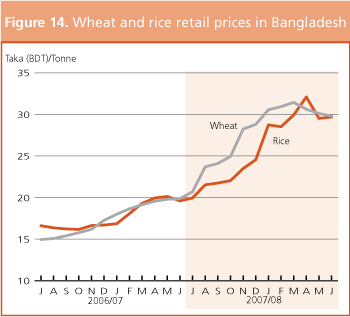
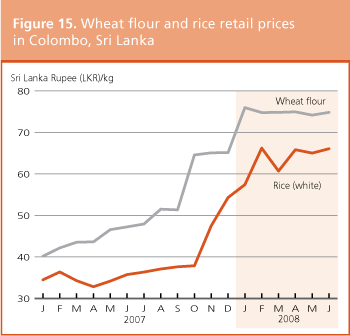
In Iraq, the 2008 wheat harvest, which has just been gathered, is estimated at 1.5 million tonnes, 36 percent down from 2007 and the lowest level in many years, after generally unfavourable growing conditions throughout the season. The reduction of the almost entirely rain-fed barley crop is even more pronounced, with output put at just 450 000 tonnes a reduction of some 60 percent compared to 2007. Imports of wheat in 2008/09, expected to remain strong on account of the low level of domestic production, are forecast at some 3.8 million tonnes, compared to 3 million tonnes in 2007. Following some improvement in the security situation, Iraqi refugees in the Syrian Arab Republic and Jordan continue to return to their homes, although large-scale movements have not yet been noted. It is estimated that around 45 000 individuals living in Syria have returned to Iraq in 2007. More than 4.2 million Iraqis have fled their homes since 2003. Of these, about 2 million are IDPs while the remainder are living as refugees in neighbouring countries, mainly Syria and Jordan. The Government has recently announced that it had allocated USD 195 million to encourage IDPs and refugees to return to their homes; this money is mostly for travel expenses for those outside Iraq, and for financial help and compensation for those whose properties were damaged during their absence. In Afghanistan, the outlook for the 2008 rain-fed harvest currently underway, and the irrigated crop later this year is not good. Precipitation across most of the country was below normal in the period October 2007-May 2008. Central areas of the country and western highland areas received less snow than usual while the normally drier south has experienced an unusually wet season this year. After a period of extreme cold conditions in January and February that caused winter wheat losses. Above-normal temperatures across most of the country aggravated the low moisture situation, by melting snow earlier and evaporating more water than normal. It is also possible that the substantial snowfall and rain deficiency this season will lead to a scarcity of irrigation water, affecting the pre-winter cultivation season in August, September and October of 2008, and thereby affecting the 2009 harvest. At this early stage, the 2008 cereal harvest is tentatively expected to reach only 4 million tonnes, nearly 15 percent less than the 2007 harvest of 4.5 million tonnes. The cereal import requirement in 2008/09 is estimated to rise to 1.2 million tonnes including food aid. An agricultural regeneration plan has been drawn up for the short, medium and long term. In the short term, improved seed and fertilizers are to be distributed to 3.4 million farmers in November and December. Also to be distributed is fodder, to over half a million farmers and insecticides to cover 450 000 hectares. It is also envisaged to establish and help 25 companies to improve seeds.
Prospects are mixed for the 2008 cereal harvest. Winter precipitation has been below normal in Central Asia, adversely affecting the winter crops and raising concern over the adequacy of spring crop irrigation reserves throughout the region, which normally come from snowmelt in the central highlands. Kyrgyzstan, Tajikistan and Turkmenistan are particularly affected. The crops in Tajikistan also suffered from extreme cold winter temperatures and locust attacks later in the season. Pending an assessment of locust damage, the 2008 cereal harvest in Tajikistan is tentatively estimated at 660 000 tonnes, nearly 20 percent below average and less than last year’s already poor harvest. By contrast, growing conditions this season have been good in Armenia, Azerbaijan and Georgia. In Uzbekistan, where rainfall was also limited, output is expected to be barely average compared to last year’s bumper crop. In Kazakhstan, where the area sown to wheat increased by 1 million hectares, the crop is officially forecast to be only about 14 million tonnes compared to last year’s record of 16.5 million tonnes. However, wheat in Kazakhstan is spring sown and the crop will not be harvested until September. Plantings were delayed by cold weather in May and below normal rainfall in the region this winter. The aggregate harvest in Kazakhstan is forecast to approach 17 million tonnes; with coarse grains accounting for 2.5 million tonnes, provided normal weather prevails until completion of the harvest. A difficult food supply situation prevails in Kyrgystan, where prices of basic foodstuffs have risen sharply between December 2007 and May 2008, for example: flour by 81 percent; butter by 100 percent; eggs by 59 percent, meat by 22 percent and vegetable oil by 20 percent. As prices of wheat and bread play an important part in the food security of the country, the Government has reached an agreement with Kazakhstan to import wheat, despite the country’s export ban. However, Kazakhstan’s exports of sunflower and vegetable oil, on which Kyrgyzstan depends for over two-thirds of its needs, are banned until 1 October, exacerbating the tight supply situation in Kyrgystan. In Tajikistan, the reduced foodcrop production expected this year, in the current environment of high food and fuel prices, will exacerbate the basic food security problem of lack of access to an adequate and balanced diet. The losses in wheat and basic foodcrops mean that the affected population will have to resort to market purchases earlier than usual, when families are already reported to be spending up to 81 percent of household income on food and unsustainable coping practices, such as taking children out of school or eating seed supplies. Prices of staples have risen sharply. Between March 2007 and March 2008, the price of wheat rose by 100 percent, bread by 86 percent, mutton by 38 percent; vegetable oil by 137 percent and pulses by 68 percent. Reflecting the poor harvest the 2008/09, cereal import requirement is estimated at a high 556 000 tonnes, mostly wheat. The country is having difficulties mobilizing supplies commercially and food aid will be necessary to bring relief to the poor.
Under favourable dry weather conditions, harvesting of the 2008 main irrigated winter wheat crop is well advanced in Mexico’s key producing states of Sonora, Guanajuato, Baja California and Michoacan. Seasonal output is expected at a record 3.4 million tonnes. 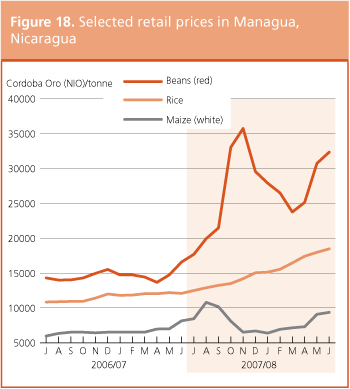
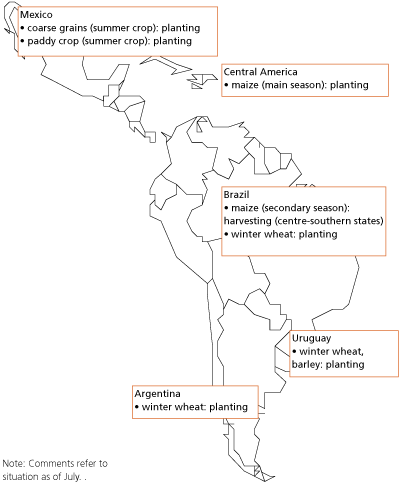
Planting of the 2008 first season (mainly rain-fed) coarse grain and bean crops is underway in all Central American countries. In Mexico, by mid-June, significant rains had arrived in western and central growing areas of the southern plateau, boosting soil moisture for planting after a few weeks of dryness. In the Caribbean, planting is still underway in Cuba, but harvesting has already stared in Haiti and the Dominican Republic where production prospects are favourable following well-distributed precipitation throughout the whole growing season. The 2008 aggregate coarse grain area is expected to reach the unprecedented level of 12.9 million hectares, some 3 percent above the previous record set last year, mostly reflecting higher planting intentions for the first season maize crop in Mexico, in response to high international prices. Planting of the 2008 main summer season paddy crop is underway throughout the subregion and planting intentions point to an area of about 693 000 hectares, slightly above the planting program of same season in 2007. Based on the results of harvests already underway and assuming normal conditions and average yields for the crops just being sown, the subregion’s aggregate cereal production is tentatively forecast at a record 42.7 million tonnes, 1.9 million tonnes more than the previous high achieved last year and about 14 percent above the average of the past five years.
Harvesting of the 2008 main season coarse grain and rice crops is well advanced and record or above-average production is expected in most countries. At the aggregate level, preliminary estimates put the subregion’s coarse grain output at a record 99.5 million tonnes, about 5.8 million tonnes above the previous record of last year. This is due to a combination of a 4.6 percent increase in maize plantings in response to high international prices and to above-average yields following favourable weather conditions throughout the growing season. In Brazil, output of the first season maize crop is officially forecast at a record 40 million tonnes, some 10 percent above the previous high last year. The increase is essentially due to higher yields following good weather conditions coupled with wider use of selected seeds and better fertilization levels. In the state of Parana, responsible of about a quarter of first season maize crop production, average yields are estimated for the first time to reach 7 tonnes per hectare, about 25 percent above the average of the past five years. In Centre-West states, current dry weather conditions are favouring harvesting of the 2008 second season (safrinha) winter maize crop that will be completed by the end of July. Output from the second season is also tentatively forecast at a record level at 18.4 million tonnes; mainly reflecting high international prices at planting time, which led farmers to increase the area sown to 5 million hectares, from 4.6 million hectares in 2007. In addition, despite some delay at planting time due to late completion of the soybean harvest, yields for the safrinha maize crop are also expected to be well above average, reaching 3.7 tonnes per hectare, due to well distributed precipitations and timely application of fertilizers. In Argentina, harvesting of the 2008 maize crop is virtually completed and preliminary official estimates point to a production of about 21 million tonnes, some 1 million tonnes less than the previous year’s level, when record yields where obtained. In Uruguay, reduced rainfall and frosts in April-May have negatively affected yields of 2008 summer season maize crop and, although official estimates are not yet available, the expected production record of 440 000 tonnes needs to be downward revised by at least 15 percent. The subregion’s aggregate production of paddy is tentatively estimated at 23.8 million tonnes, about 8 percent above the output obtained in 2007 following larger crops in Argentina, Brazil, Colombia, Uruguay and Venezuela where harvesting is virtually completed. Planting of the 2008 winter wheat crop, to be harvested by the end of the year, is well advanced in key growing areas of Brazil and Paraguay, while some delay is reported in Argentina and Uruguay due to low soil moisture levels. In Argentina, the main wheat producer of the subregion, official wheat planting intentions have been gradually reduced since May (with a reduction of half a million hectares) as a consequence of dry weather conditions, coupled with higher costs for agrochemicals and fuel shortages that have caused farmers to shift away from wheat. In Brazil, planted area is expected to increase by some 22 percent compared to the previous year in response to good prospects for returns given an increase in the Government’s guaranteed minimum price coupled with Argentina’s (a traditional supplier of wheat to Brazil) export ban. Based on latest indications, the subregion’s aggregate planted area is tentatively forecast at 8.8 million hectares, some 6 percent above the previous year’s level and very similar to the last five-year average. However, the final area will still depend on weather conditions through the remainder of the planting season, especially in Argentina and Uruguay, where planting progress has been hampered by dry conditions.
In the United States, winter wheat harvesting was well underway in the southern states as of late June, but progressing a little behind average pace because of some heavy rainfalls. Although there is some concern that the adversely wet conditions may have some negative impact on grain quality, especially in the major producing state of Kansas, so far there are no indications of quantitative losses. The latest official forecast puts the winter wheat output at some 49 million tonnes, nearly 20 percent up from the previous year. Latest indications also continue to point to a larger spring wheat harvest, with the bulk of the crop reported to be in good to excellent condition in late June, and the area estimated to be up be about 9 percent compared to last year. Thus, aggregate wheat output is forecast to reach some 66 million tonnes, up 10 million tonnes on the previous year and the largest crop since 1998. Regarding coarse grains, prospects have deteriorated considerably in the past few weeks due to persistent heavy rains delaying maize planting in many major growing areas, causing the loss of crops already in the ground through flooding. According to the official USDA Acreage Report of 30 June, which already attempted to factor in the affect of the adverse rains through a special last-minute survey in late June, the harvested maize area in 2008 could turn out to be about 31.9 million hectares, down from 35 million hectares in 2007. Although a large part of the decline was already expected due to smaller planting intentions this year, the adverse conditions could result in a decline in the harvested/planted ratio, with some lost crops not being replanted or being replanted, or more area being turned over to other crops such as soybean that have a shorter growing cycle. Given some likely reduction in yield prospects for crops sown late or damaged by excessive water, the United Sates total maize crop in 2008 is now forecast at about 293 million tonnes, but much will still depend on weather conditions in the coming months. 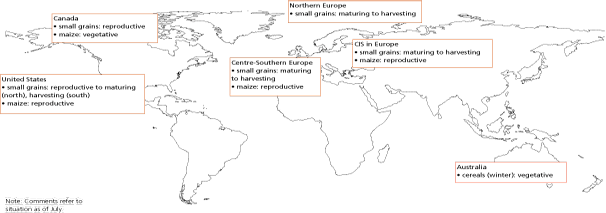
In Canada, prospects for the 2008 grain crops remain favourable. In response to strong prices, farmers have increased the total wheat area by about 16 percent after a switch in favour of oilseeds last year. The area in durum wheat in particular, which generally offers the best returns, is reported to have increased sharply by nearly 27 percent. However, contrary to the normal pattern of rotational shifts in recent years, between wheat and oilseeds cultivation, this year’s large wheat area has not come at the expense of oilseeds, and the canola area for the 2008 harvest has also increased to a record level, reflecting good price prospects for this crop also. While some of the increased area of wheat and canola has come from a drop in land planted to the main feed grains barley and oats, the increase has also been supported by bringing into production land areas traditionally dedicated to summer fallow, which in the Prairie provinces have declined to record low levels in recent history. Assuming normal conditions through the growing season, the country’s 2008 wheat crop is forecast to reach 24.8 million tonnes, about 24 percent up from 2007.
Prospects for the 2008 cereal crops in the European Union remain favourable. The aggregate cereal output of the 27 countries is forecast at nearly 296 million tonnes, 13.6 percent up from the previous year. Most of the increase is expected in eastern parts among the newest member states, where growing conditions have been particularly good this year and yields and output are set to recover sharply from last year’s drought-reduced levels. However, among the central and northern countries, where the compulsory land set-aside requirement was removed for the 2007/08 production season, increased plantings and better expected yields are also contributing to the group’s increased harvest this year. Of the total cereal forecast, wheat is expected to account for 138 million tonnes, almost 15 percent up from last year, while output of coarse grains is seen to rise to 155 million tonnes, nearly 13 percent up from 2007. In the Balkan region among the non-EU countries, the outlook for the 2008 cereal harvest is also satisfactory and output is set to recover well from the drought'reduced level of 2007. In Serbia, good yields have partially offset a reduction in the area sown to wheat and output is estimated at 1.7 million tonnes. This would be enough to cover domestic needs but leave little surplus available for export. By contrast, output of maize is forecast to rise from 4 to 6 million tonnes which, if materialized could leave an exportable surplus of about 1 million tonnes. In the European CIS, the spring grain plantings are mostly complete and early harvesting of the winter crops planted in 2007 is underway. Throughout the region, winter wheat, barley and rye have over-wintered well and moisture supplies for spring grain development are adequate. Reflecting high cereal prices in 2007, the aggregate area sown to wheat is estimated to have increased by 2.4 million hectares to 33.8 million hectares. Reflecting good growing conditions both through the winter and the spring/summer to date, the aggregate output of wheat in the subregion is forecast to rise to 73 million tonnes, 13 percent above the good harvest in 2007. Similarly, the outlook for coarse grains, which are still developing, is good. The area sown increased by 1.6 million hectares, and provided normal weather prevails until the completion of the harvest, indications are that average yields will recover sharply form last year’s drought-affected levels. Coarse grain output is tentatively forecast to reach 59.5 million tonnes or 18 percent more than last year. In the Russian Federation, the subregion’s largest producer, the aggregate grain area for the 2008 harvest is forecast at nearly 46 million hectares, 2.6 million hectares more than in 2007. Wheat output is forecast at a bumper 51 million tonnes, while that of coarse grains could reach almost 32 million tonnes. Grain exports in the period 1 July 2007 to 30 May 2008 have reached 13.2 million tonnes, 1 million tonnes more than in the preceding year (2006/07 July/June), and more or less accounting for the country’s estimated export surplus in 2007/08. The high export duties introduced on 29 January 2008 (after the bulk of surplus from the 2007 harvest had been sold) have been repealed with effect 1 July. If the 2008 harvest forecast materializes, the country will again have a substantial surplus over expected domestic needs, although some of this will be needed to replenish government intervention stocks. In Ukraine, harvesting has started and provided weather conditions remain normal to the completion of the harvest the 2008 aggregate cereal output is forecast at some 40 million tonnes, 46 percent above last year’s drought-reduced crop. Wheat production could reach 20 million tonnes with coarse grains making up the bulk of the balance. The country’s exports in 2007/08 (July/June), from the 2007 harvest, are estimated at some 3 million tonnes, less than the estimated surplus and carryover stocks have increased significantly. However, export quotas have been lifted and the country could have an exportable surplus of 12 million tonnes in 2008/09. In both Ukraine and the Russian Federation grain prices have weakened significantly in the past few weeks in view of the upcoming good harvests.
The prospects for the 2008 winter cereal crops in Australia were generally favourable as of late June, although the planting season did not progress as well as had been hoped earlier. With the exception of Western Australia, most of the country’s main winter cropping regions received below-average autumn rainfall, which meant many crops were sown in dry conditions or after the optimum planting window where farmers waited for rain before starting fieldwork. However, despite the difficulties of the planting period, the area sown to wheat is forecast to rise by 13 percent to a record 14 million hectares, reflecting relatively strong prices, encouraging farmers to maximise plantings, also by taking land out of pasture, to try and improve short-term cash flow after two drought years. Based on this area forecast, and assuming normal weather for the remainder of the season, the official ABARE forecast in mid-June puts the country’s total wheat production in 2008 at 23.7 million tonnes, an increase of some 80 percent from the previous year’s drought-reduced crop. Barley output is also seen to increase sharply after last year’s drought, recovering to almost 8 million tonnes after just 6 million tonnes produced in 2007. Output of the 2008 summer grain crop (mostly sorghum and maize), which has already been gathered, is estimated to have increased sharply but rice output fell sharply reflecting lack of irrigation water reserves in the main producing area. |
||||||||||||||||||||||||||||||||||||||||||||||||||||||||||||||||||||||||||||||||||||||||||||||||||||||||||||||||||||||||||||||||||||||||||||||||||||||||||||||||||||||||||||||||||||||||||||||||||||||||||||||||||||||||||||||||||||||||||||||||||||||||||||||||||||||||||||||||||||||||||||||||||||||||||||||||||||||||||||||||||||||||||||||||||||||||||||||||||||||||||||||||||||||||||||||||||||||||||||||||||||||||||||||||||||||||||||||||||||||||||||||||||||||||||||||||||||||||||||||||||||||||||||||||||||||||||||||||||||||||||||||||||||||||||||||||||||||||||||||||||||||||||||||||||||||||||||||||||||||||||||||||||||||||||||||||||||||||||||||||||||||||||||||||||||||||||||||||||||||||||||||||||||||||||||||||||||||||||||||||||||||||||||||||||||||||||||||||||||||||||||||||||||||||||||||||||||||||||||||||||||||||||||||||||||||||||||||||||||||||||||||||||||||||||||||||||||||||||||||||||||||||||||||||||||||||||||||||||||||||||||||||||||||||||||||||||||||||||||||||||||||||||||||||||||||||||||||||||||||
| GIEWS | global information and early warning system on food and agriculture |